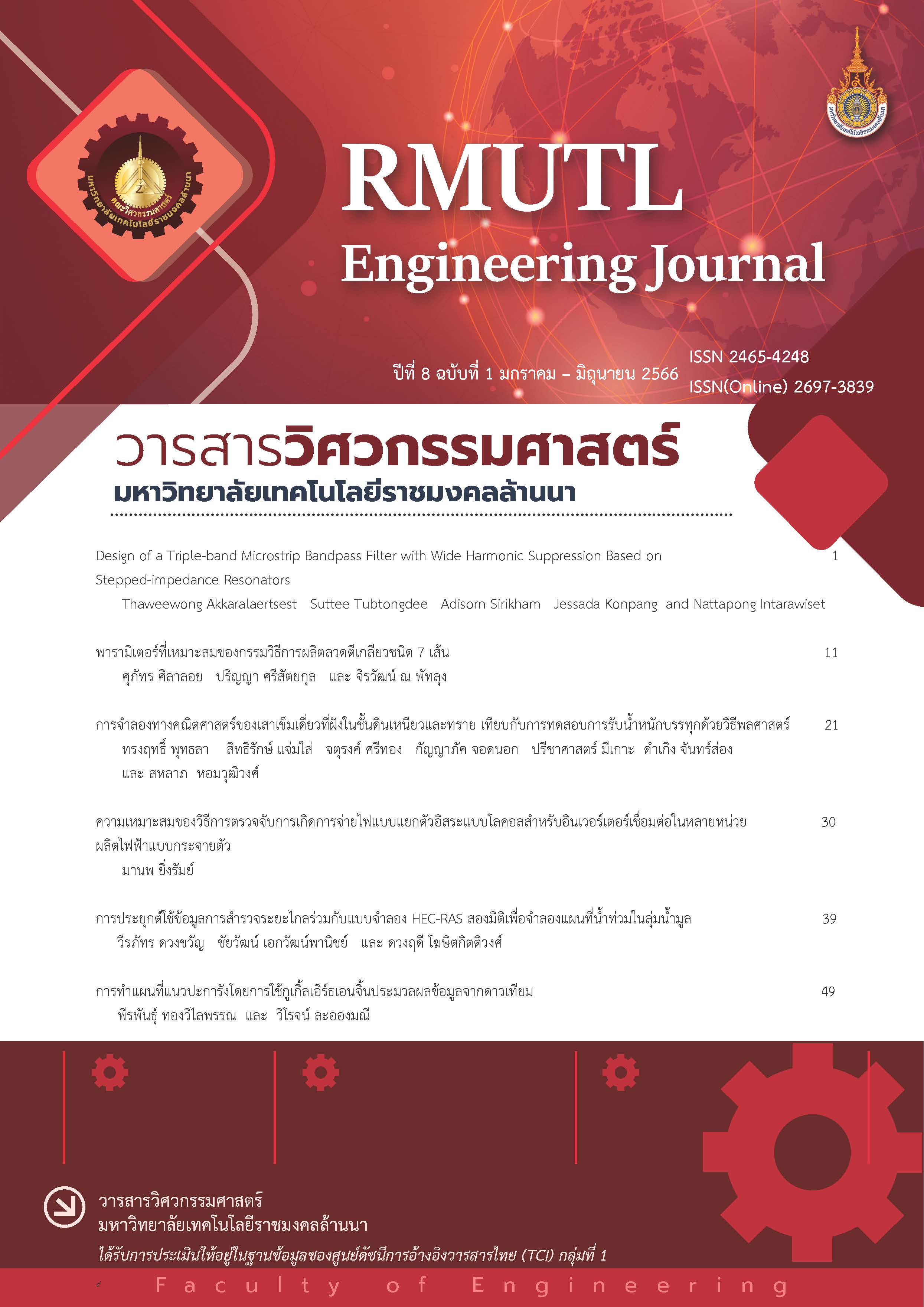Application of Remote Sensing Data with HEC-RAS 2D Model to Simulate Floodplain in Mun River Basin
DOI:
https://doi.org/10.14456/rmutlengj.2023.5Keywords:
HEC-RAS 2D model, Inundation area, LANDSAT-8 satellite imagery, Land use classification, Mun RiverAbstract
This paper presents an application of remote sensing data using LANDSAT-8 satellite images for land use identification to estimate Manning's roughness coefficient. Then, the land use from satellite images with a two-dimensional HEC-RAS mathematical model is presented. The accuracy of the land use classification was tested, and four categories of land use were categorized using the minimum distance which is a supervised classification technique. Then, the Manning’s roughness coefficient determined from the land-use data was used for two-dimensional simulation. To calibrate and validate this study, data from 2011 and 2014 were used. The best result has an NSE of 0.95-0.97 and an R2 of 0.96-0.99, indicating that it is highly accurate. This two-dimensional
HEC-RAS model has the benefit of being able to simulate flooded regions in varied land use characteristics while using remote sensing data from LANDSAT-8 satellite images.
References
Al-Ahmadi FS, Hames AS. Comparison of four classification methods to extract land use and land cover from Raw Satellite Images for Some Remote Arid Areas, Kingdom of Saudi Arabia. Journal of King Abdualziz University - Earth Sciences. 2009;20:167-91.
Lu D, Mausel P, Batistella M, Moran E. Comparison of land-cover classification methods in the Brazilian Amazon Basin. Photogrammetric Engineering & Remote Sensing. 2004;70:723-31.
Yuan F, Sawaya KE, Loeffelholz BC, Bauer ME. Land cover classification and change analysis of the Twin Cities (Minnesota) Metropolitan Area by multitemporal Landsat remote sensing. Remote Sensing of Environment. 2005;98(2-3):317-28.
Lu D, Batistella M, Moran E. Land-cover classification in the Brazilian Amazon with the integration of Landsat ETM+ and Radarsat data. International Journal of Remote Sensing. 2007;28(24):5447-59.
Kavzoglu T, Colkesen I. A kernel functions analysis for support vector machines for land cover classification. International Journal of Applied Earth Observation and Geoinformation. 2009;11(5):352-9.
Aitkenhead MJ, Aalders IH. Classification of Landsat Thematic Mapper imagery for land cover using neural networks. International Journal of Remote Sensing. 2008;29(7):2075-84.
Garcia M, Juan A, Bedient P. Integrating Reservoir Operations and Flood Modeling with HEC-RAS 2D. Water. 2020;12(8).
Alfred K, Steven B, Timothy M. Effect of land use-based surface roughness on hydrologic model output. Journal of Spatial Hydrology. 2009;9:51-71.
Pinos J, Timbe L. Performance assessment of two-dimensional hydraulic models for generation of flood inundation maps in mountain river basins. Water Science and Engineering. Eng. 2019;12(1).
Secretaría Nacional del Agua (SENAGUA), 2014. Vulnerability Assessment to Flood Events of the Santa Barbara River, Volume 2: Hydraulic Study. SENAGUA, Quito, p. 108 (in Spanish).
Huang J, Zhou P, Zhou Z, Huang Y. Assessing the influence of land use and land cover datasets with different points in time and levels of detail on watershed modeling in the North River Watershed, China. Int J Environ Res Public Health. 2012;10(1):144-157.
Rwanga SS, Ndambuki JM. Accuracy Assessment of Land Use/Land Cover Classification Using Remote Sensing and GIS. International Journal of Geosciences. 2017;08(04):611-22.
Brunner GW. HEC-RAS, River Analysis System Hydraulic Reference Manual. US Army Corps of Engineers; 2016. Report No.: CPD-69.
Connell RJ, Painter DJ, Beffa C. Two-Dimensional Flood Plain Flow. II: Model Validation. Journal of Hydrologic Engineering. 2001;6(5):406.
Liu, Z, Merwade, V, Jafarzadegan, K. Investigating the role of model structure and surface roughness in generating flood inundation extents using one- and two-dimensional hydraulic models. J Flood Risk Management. 2019;12:e12347.
Downloads
Published
How to Cite
Issue
Section
License

This work is licensed under a Creative Commons Attribution-NonCommercial-NoDerivatives 4.0 International License.










